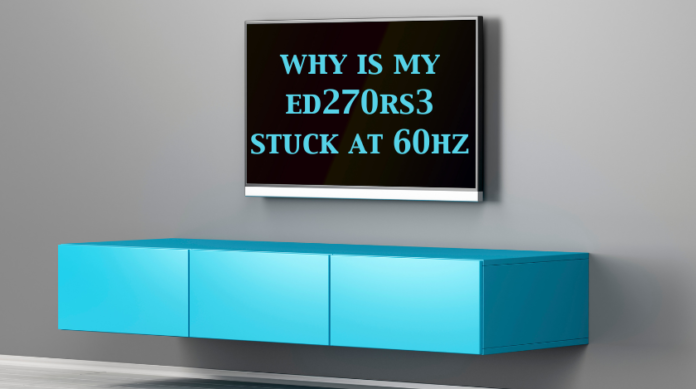I remember the day I upgraded my monitor to the Acer ED270RS3, hoping for buttery-smooth 165Hz gaming. But when I first set it up, I was puzzled—no matter what I did, the screen refused to go above 60Hz. If you’re in the same boat, don’t worry; I’ve been there, and I know exactly how frustrating it can be. Let me walk you through the common causes and solutions to get your monitor running at its full potential.
1. Check Your Cable Type
This was my first mistake. I had everything connected, but my monitor wouldn’t budge past 60Hz. It turned out that my HDMI cable was the culprit. Not all HDMI cables support high refresh rates.
Solution: Use a DisplayPort cable or an HDMI 2.0 (or higher) cable to unlock 165Hz. Older HDMI 1.4 cables are often limited to 60Hz on 1080p screens.
2. Update Your Graphics Drivers
Outdated drivers can prevent your system from recognizing the monitor’s true refresh rate. When I updated my GPU drivers, the 165Hz option magically appeared in my settings.
Solution: Go to your GPU manufacturer’s website (NVIDIA, AMD, or Intel) and download the latest drivers.
3. Adjust Your Display Settings
When I finally had the right cable and drivers, I still faced a 60Hz lock. Turns out, I hadn’t changed my display settings.
Solution:
- On Windows, right-click your desktop and select Display settings.
- Scroll down to Advanced display settings.
- Under Refresh rate, select 165Hz from the dropdown menu.
4. Verify Your Monitor’s Settings
The ED270RS3’s on-screen display (OSD) menu can sometimes default to 60Hz. I had to manually toggle the refresh rate within the monitor settings.
Solution: Use the monitor’s buttons to access the OSD menu and enable the correct refresh rate mode.
5. Check Your Resolution Settings
Running your monitor at a higher resolution than recommended can limit refresh rates. I once set my resolution to 4K by mistake, which locked my refresh rate at 60Hz.
Solution: Ensure your resolution is set to 1920×1080 (Full HD) to achieve the full 165Hz capability.
6. Inspect Your GPU’s Capabilities
If you’re running an older graphics card, it may not support higher refresh rates. I once tried connecting my old GTX 750 Ti, only to realize it couldn’t push 165Hz.
Solution: Check your GPU specs online to confirm it supports 165Hz at 1080p resolution.
7. Try Different Ports
On one occasion, I plugged my DisplayPort cable into the wrong port on my GPU, which was limited to lower refresh rates.
Solution: Switch to another DisplayPort or HDMI 2.0 port to see if that resolves the issue.
Conclusion
If your Acer ED270RS3 monitor is stuck at 60Hz, the fix is often simpler than it seems. Start by checking your cable type, updating your drivers, and adjusting your display settings. With the right setup, you’ll be enjoying the smooth, high-performance experience you expected. I know I did—and my gaming has never been better since. Happy gaming!
FAQ
Q: Why won’t my ED270RS3 show 165Hz in my settings?
A: This is often due to using an outdated cable, incorrect display settings, or missing GPU driver updates.
Q: Can HDMI cables handle 165Hz?
A: Yes, but only HDMI 2.0 or higher. HDMI 1.4 is limited to 60Hz at 1080p.
Q: Does my PC need a specific GPU for 165Hz?
A: Yes, ensure your GPU supports high refresh rates at 1080p. Models like GTX 1060 or RX 580 and above should work well.


